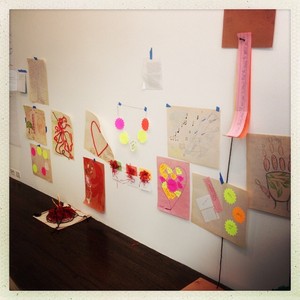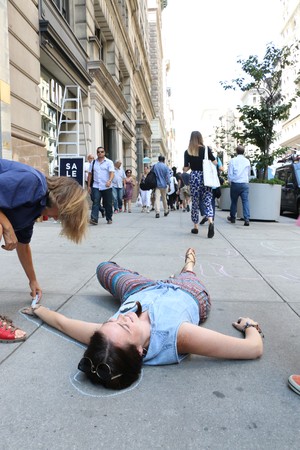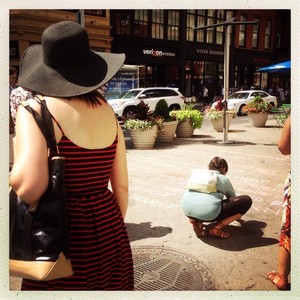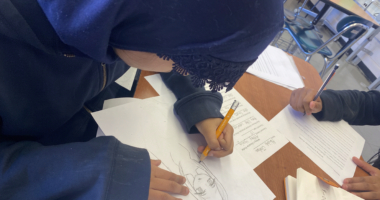As a recent graduate of CWP’s Teaching Artist Training & Internship Program (TATIP), I am familiar with the ways in which TATIP facilitators Renée Watson and Patti Chilsen seamlessly model effective teaching practices throughout their professional development workshops. It should have come as no surprise to me when I reflected upon my time in this year’s Summer Institute and realized they had done it again. One of our first topics of discussion during this 3 day institute was Bree Picower’s Six Elements of Social Justice Curriculum Design. We talked about what each principle meant and the various ways to address them with our students. The conversation was dynamic, but as the workshop progressed I thought about it little, instead delighting in various art projects and subsequent discussions. It wasn’t until I reviewed the six elements days after the Institute was over that I realized Renée and Patti perfectly scaffolded each element throughout our time together demonstrating not only the effectiveness of Picower’s elements, but also their practical possibilities.
1. SELF-LOVE AND KNOWLEDGE
Before we can ask our students to participate in social activism, we must first teach them to know and love themselves. One cannot fully promote the empowerment of others until she has found it in herself. During the Institute, each Teaching Artist explored her/his personal history, values and passions through the creation of individual artist maps. These maps, as well as our numerous opportunities for reflective journaling, encouraged us to discover and/or reaffirm what is most important to us as artists, educators and activists.

2. RESPECT FOR OTHERS
According to Picower, the goal of this element is to “create a climate of respect for diversity through students learning to listen with kindness and empathy to the experiences of their peers.” Throughout the Institute, we were continuously asked to both engage in discussion and collaborate artistically with our peers. With our fearless leaders at the helm, we created a community culture in which we simultaneously explored and celebrated our similarities and differences.

3. EXPLORING ISSUES OF SOCIAL INJUSTICE
Once self-love and respect of others are mastered, it is necessary to expose students to ways in which diversity has impacted various groups of people differently, as well as how historical injustices affect our present day. This exploration happened naturally during the Institute, as each Teaching Artist brought her/his individual experiences of injustice into the room. Our group brainstorms and discussions facilitated the sharing of these experiences, allowing us all to act as both teacher and student.

4. SOCIAL MOVEMENTS AND SOCIAL CHANGE
It is never more important to seek inspiration from those who came before then when teaching for social justice. It is crucial students learn about ordinary people who have successfully come together to create change, but that they also understand change often takes much longer than it should. On the first day of the Institute, we created a list of socially active artists who inspire us. As we discussed and added to the list throughout the workshop, Renée and Patti continuously reminded us that working for social justice “is a lifelong thing and we have to help young people know that.”

5. RAISING AWARENESS
After their spark has been lit, we must ask students to become advocates for issues about which they feel passionately. Whether it be a performance for the community, a public mural, a letter writing campaign, or anything in between, we should encourage students to raise awareness of social injustices in their world. Renée and Patti did just that when they asked us on Day 2 to turn our poems inspired by the BlackLivesMatter movement into street art and perform for unsuspecting passerbys near busy Union Square. The exhilaration and terror felt during this experience beautifully mirrored how we often ask our students to push themselves.


6. TAKING SOCIAL ACTION
Although awareness is important, true change comes from action. We must help students to identify ways in which they can take meaningful steps towards justice and facilitate their doing so, when possible. Throughout the entirety of the Institute, we were inspired to continue to address issues of injustice in our teaching. Moreover, we were encouraged by both Renée and Patti, as well as our peers that while teaching for social justice is challenging, never-ending, and at times discouraging, it has the potential to profoundly change lives, and thereby the world.

Although we never talked about Picower’s six elements after that initial discussion, throughout the Institute we used all of the elements to become more informed, open and confident Teaching Artists. And once again, Renée and Patti demonstrated that sometimes the most effective way to teach and inspire is simply by example.
-Laura Epperson, 2014-15 TATIP Graduate, Theatre Artist
Interested in Summer Institute? Find out more about it in our Summer Institute 5.0 Anthology.
Want to know more about Professional Developement opportunities with CWP? Check out our Teaching Artist Training & Internship Program (TATIP).



